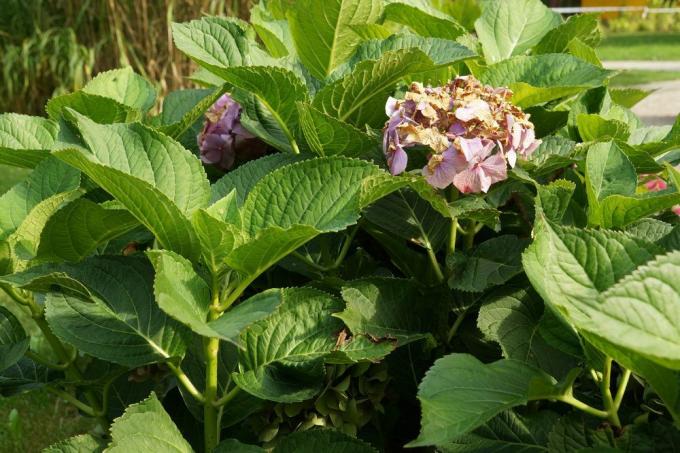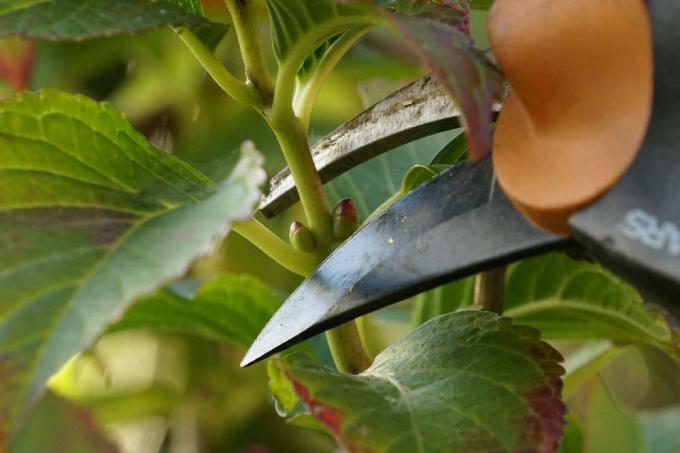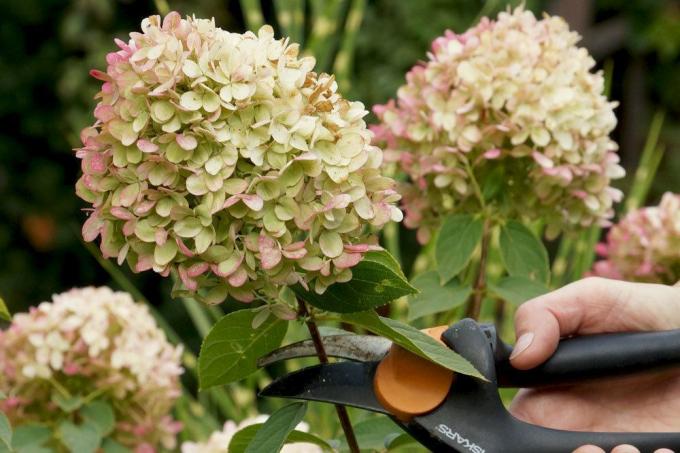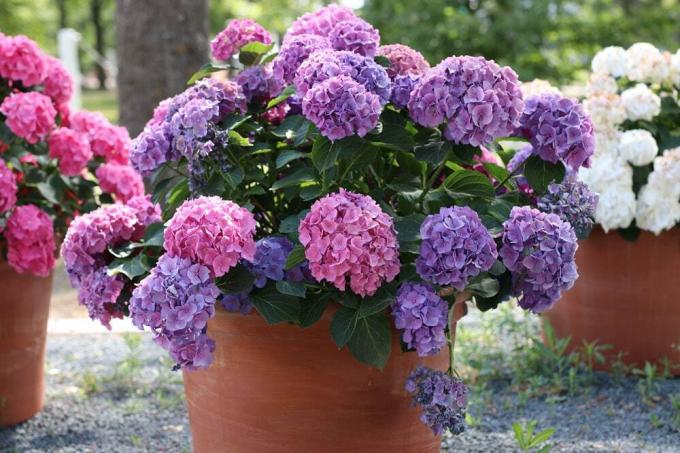
table of contents
- Hydrangeas very robust
- Measures in spring
- Late frosts are particularly dangerous
- Prevent frost damage
- Apply suitable winter protection
- Winter protection for container plants
- frequently asked Questions
Hydrangeas are those Stars in every cottage garden. The robust garden plants survive many a cold winter. However, hydrangeas can sometimes be frozen to death in spring. All measures for prevention and help are given below.
In a nutshell
- A hydrangea is one of the more robust garden plants
- Late frosts can be particularly dangerous
- Frozen shoots are light brown to dark brown and dry
- No pruning should be done in autumn
- Winter protection can prevent frostbite
Hydrangeas very robust
Hydrangeas are usually one of the more robust garden plants. They are conditionally hardy and survive many periods of frost. However, they are very sensitive to late frosts that occur in the spring after the new shoots have emerged. Hydrangeas are particularly susceptible to this, as they planted the flowers for the coming gardening season in the previous year. It can quickly happen that the tender buds fall victim to the frost. In other words, they froze to death. These include farm hydrangeas (Hydrangea macrophylla) and plate hydrangeas (Hydrangea serrata). Frost damage to hydrangeas can be seen:
- on light brown to dark brown shoots
- Shoots often dry

Sometimes the perennials appear frozen after winter, but they are not. To be really sure whether the shoots are dead, simply scratch the bark lightly with the thumbnail. If it comes off easily and a green, juicy tissue appears underneath, there is still life in the shoots. On the other hand, a slightly yellowish-green discoloration to under the last pair of eyes indicates that the shoot has dried up and is dead.
Note: Shade-loving hydrangeas are less susceptible to frost damage in winter, like hydrangeas that prefer a sunny location.
Measures in spring
Normally, in the spring of a hydrangea, only the withered, old flowers just above the top pair of eyes are cut off. In the case of frozen shoots, however, only a complete cut back will usually help.
In addition:
- Cut back to the first living pair of buds
- completely remove the drive in the event of severe damage
- do not prune back too early
- optimal time at the end of February / beginning of March
- thin out the hydrangeas next to them
Sometimes it can also happen that a hydrangea is more severely damaged in very cold winters with strong frosts. However, this happens relatively less often. In this case, a complete cut should be made down to the ground. With a lot of luck and patience, the plant will then sprout again. However, there are differences in the individual species and varieties in terms of the number of flowers to be expected after pruning.

Hydrangea with flowers in the previous year
- these include plate hydrangeas (Hydrangea serrata), farmer's hydrangeas (H. macrophylla), velvet hydrangeas (H. sargentiana) and climbing hydrangeas (H. petiolaris)
- the more blatant the cut, the less the flowers
- with radical pruning, flowering fails completely in that year
Hydrangea with flowers on the "new" wood
- these include snowball hydrangeas (Hydrangea arborescens) and panicle hydrangeas (H. paniculata)
- Pruning does not affect the number of flowers
- Buds are always planted in the same year
- however, there must be one pair of eyes per shoot
However, if there are no longer any living shoots with a pair of buds, it is advisable to dig up the hydrangea and replace it with a new one.
Note: When buying, you should already pay attention to the winter hardiness of the corresponding hydrangea so as not to be surprised in the coming spring. The plant label provides information about the respective winter hardiness. In addition, advice from a specialist is advisable.
Late frosts are particularly dangerous
Especially after the new shoots, frosts in the months of April / May can severely damage the young and still soft shoots. If the temperature falls far below -5 ° C, then it is hardly possible to save this year's blooms. However, if only the young leaves are affected, they are simply removed. They are subsequently replaced by new ones. It is not necessary to cut back the shoots. However, it looks different when the shoot tips hang down. Then you have to use scissors and shorten the affected shoot to the next pair of living eyes. A light winter protection is recommended during this time.

Prevent frost damage
In order to avoid frost damage to hydrangeas in advance during the cold season, certain measures should be taken. It starts with the choice of location. This can already prevent damage. This also includes:
- Protection from cold easterly winds
- Avoid strong sunlight, especially in winter
- Sun favors early budding
- later frosts then cause major damage
- Do not cut off withered flower heads in autumn
- provide protection for underlying buds
- no pruning in autumn
- Remove dead wood, a source of rot, fungi and pathogens
- Shorten long protruding shoots, risk of snow breakage
- Stop nitrogen fertilization from July
- Organic fertilizer can be given until August
- optimal application of potash-based fertilizers such as patent potash
- thereby maturation and lignification of the shoots by winter
- Stop fertilizing completely from September
- water sufficiently in autumn
- Avoid waterlogging
- if the roots are damaged, the plant is more susceptible to frost damage
Tip: Administration of fertilizer rich in potash well into September increases the frost hardiness of the plants. The nutrients strengthen the cell walls and at the same time lower the freezing point of the existing cell water. Comfrey manure is also ideally suited as autumn fertilization in addition to Patentkali.

Apply suitable winter protection
Although hydrangeas are relatively winter-proof, it is advisable to apply additional winter protection, especially in rough areas. Such winter protection is particularly important for young plants that were only planted in the spring of the same year. These are not yet deeply rooted during the short time and frost damage can occur more quickly here. Before the onset of winter, various protective measures should now be taken:
- Mulch root slices
- to do this, apply a 10 cm high layer of leaves
- cover these with fir twigs
- Pile up the root neck 10 to 20 cm high
- suitable for garden or compost soil
- Cover shoots with breathable winter fleece
- alternatively lay wire mesh loosely over shoots
- then cover with fir twigs
- Another alternative: stick sticks around the plant
- Hydrangea has to be able to breathe
- apply winter protection again after pruning if there is a risk of ground frost
- Completely remove winter protection no later than mid-May
- otherwise fungal infestation is favored by rising temperatures
Tip: Do not use foils or other airtight materials. Condensation forms underneath and rot quickly occurs.
Winter protection for container plants
Of course, a hydrangea in the tub also needs adequate winter protection during the cold season. Otherwise it can quickly happen that the shoots or even the entire plant will freeze to death in spring. The following precautions should be taken:

- Installation of the bucket in a sheltered place
- Place the bucket on a frost-proof surface
- suitable wooden board or styrofoam
- Cover the root disc with leaves and fir branches over it
- Cover the bucket with bubble wrap, coconut mats or a jute sack
- Cover the shoots with special winter fleece
- It is better to overwinter buckets with a diameter of less than 35 cm in the house without frost
- temperatures between 3 and 5 ° C
- cool temperatures favor flower formation
Note: Not only can frost damage a hydrangea, the drought stress in winter has an even worse effect on the plant. Sunshine, cold frosts with low temperatures and of course a lack of snow cover can quickly lead to the root ball drying out. It is therefore advisable to water the plant a little on frost-free days.
frequently asked Questions
When choosing, varieties should first come into question, which thrive particularly well in the shade. In any case, they are hardier than a sun-loving hydrangea. In addition, the trade offers varieties that are well tolerated by frost. These include:
Farm hydrangea
Garden hydrangea
Japanese hydrangea
Forest hydrangea
Climbing hydrangea and
Plate hydrangea.
The plant labels provide information about this. Expert advice is of course even better.
The prerequisite for a blue color is an acidic soil. The pH should be below 4.5. However, normal garden soils do not show this value. Therefore, before planting a hydrangea, the garden soil should be exchanged for hydrangea or rhododendron soil. In addition, aluminum must be regularly added to the irrigation water. Special hydrangea blue or, alternatively, potash alum are available in stores. Please use only according to the instructions on the packaging. The discoloration lasts for a long time up to two years.
It should be noted that there are hydrangea varieties for sunny (panicle hydrangea) and shady locations (including farm hydrangea). Furthermore, these perennials love deep, nutritious, humus-rich and loose soil. This should be able to store water well, as hydrangea translates as "water slurper", which in turn provides information about the water requirements of the plants. It is relatively high. A special hydrangea or rhododendron soil is ideal for planting. In addition, it must be noted that the pH of the soil must be in the acidic range.
